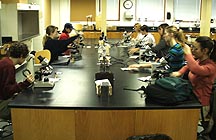

Updated 7 February 05
Week 1 Laboratory orientation; Safety and directions;
Use of microscopes;Handling and examining cultures;
Electronic resources: E-mail, Web resources
2 Microscopic observation and culture: Bright field and phase-contrast
Wet mounts, hanging drops, smears, stains, "Pet" culture
3 Preparation of growth media: Plates, slants, broth
Inoculation of cultures; Microbial analysis of environmental sources
4 Differential & selective media:
EMB, MacConkey, TSI, IMViC, Vogel-Johnson, XLD
5 Enzyme tests: Differentiation of bacterial species.
6 Dilution technique to estimate population numbers:
Pour-plate, spread plate
Group investigation project
7 Environmental effects on microorganisms:
Temperature, disinfectants, uv light, antibiotics
8 Estimating fecal contamination: Food & water
9 Completion of group project.
Virtual unknown identification via Identibacter Interactus.
10 Identifying unknown bacteria from a mixed culture.
11 Unknowns continued.
12 Unknowns due
13 Lab cleanup
Notes:
 Biology
HomePage
Biology
HomePage GC HomePage
GC HomePage